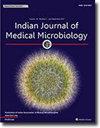A systematic review and meta-analysis to develop a landscape map of antibiotic resistance for six WHO priority pathogens in east and north-east India from 2011 to 2022
IF 1.4
4区 医学
Q4 IMMUNOLOGY
引用次数: 0
Abstract
Background
Determining regional patterns of antimicrobial resistance in bacterial infections in the healthcare setting (AMR) identifies surveillance gaps and informs policies for mitigation. We estimated the prevalence of AMR for six WHO priority pathogens in diagnostic and surveillance samples in the twelve east and north-east Indian states from 2011 to 2022 (PROSPERO ID: CRD42021278961).
Methods
Studies were searched on Medline, Scopus, and Web of Science. Observational, descriptive, and cross-sectional studies, reporting AMR based on laboratory diagnostics, in individuals from east and north-east India from 2011 to 2022 were included. Four reviewers in pairs conducted abstract, full-text screening, and data extraction. We estimated the prevalence of resistance in fifty-four pathogen-antibiotic combinations, and six antibiotic resistance patterns. Pooled estimates of prevalence (Ɵ), heterogeneity (I2), and 95 % confidence intervals were calculated using the random effects model.
Results
Fifty-five studies were included. Information was available for nine states, none from Arunachal Pradesh, Mizoram, and Nagaland. E. coli was most frequently isolated (59.2 %, 95 % CI: 48.8–69.6 %), followed by S. aureus (36.2 %, 95 % CI: 20.2–52.2 %), Enterococcus (27.5 %, 95 % CI: 11.2–43.7 %), Klebsiella (25 %, 95 % CI: 15–35 %), Acinetobacter (15.7 %, 95 % CI: 2.3–29.1 %), and Pseudomonas aeruginosa (15.7 %, 95 % CI: 4.1–27.3 %). There was high prevalence of ESBL (45 %, 95 % CI: 35–55 %) and carbapenem resistance (30 %, 95 % CI: 22–38 %). AmpC (23 %, 95 % CI: 9–37 %) and colistin resistance was lower (10 %, 95 % CI: 0–22 %) but supporting data was limited. Overall prevalence of MRSA was 26 % (95 % CI: 14–39 %), and VRE was 9 % (95 % CI: 0–17 %).
Conclusion
High prevalence of resistance was seen to all first-line antibiotics. Gram positive bacteria had high resistance to penicillins, and Gram negatives to third-generation cephalosporins, beta-lactam/beta-lactamase inhibitors, and carbapenems. Aminoglycoside, fluoroquinolone, and trimethoprim-sulphamethoxazole resistance was common across all genera. Critical regional AMR information gaps exist.
为绘制 2011 年至 2022 年印度东部和东北部六种世界卫生组织重点病原体的抗生素耐药性分布图而进行的系统回顾和元分析。
背景:确定医疗环境中细菌感染的抗菌药耐药性(AMR)的区域模式可以发现监测差距,并为缓解政策提供信息。我们估计了 2011 年至 2022 年印度东部和东北部十二个邦的诊断和监测样本中六种世界卫生组织优先病原体的 AMR 流行率(PROSPERO ID:CRD42021278961):方法:在 Medline、Scopus 和 Web of Science 上搜索相关研究。方法:在 Medline、Scopus 和 Web Science 上检索了 2011 年至 2022 年期间根据实验室诊断报告印度东部和东北部个人 AMR 的观察性、描述性和横断面研究。四名审稿人结对进行摘要、全文筛选和数据提取。我们估算了 54 种病原体-抗生素组合和 6 种抗生素耐药性模式的耐药性流行率。使用随机效应模型计算了流行率的汇总估计值(Ɵ)、异质性(I2)和95%置信区间:结果:共纳入 55 项研究。结果:共纳入 55 项研究,其中 9 个州有相关资料,阿鲁纳恰尔邦、米佐拉姆邦和那加兰邦没有相关资料。大肠杆菌最常被分离出来(59.2%,95% CI:48.8-69.6%),其次是金黄色葡萄球菌(36.2%,95% CI:20.2-52.2%)、肠球菌(27.5%,95% CI:11.2-43.7%)、克雷伯氏菌(25%,95% CI:15-35%)、醋杆菌(15.7%,95% CI:2.3-29.1%)和铜绿假单胞菌(15.7%,95% CI:4.1-27.3%)。ESBL(45%,95% CI:35-55%)和碳青霉烯耐药率较高(30%,95% CI:22-38%)。AmpC(23%,95% CI:9-37%)和可乐定耐药率较低(10%,95% CI:0-22%),但支持数据有限。MRSA 的总体流行率为 26%(95% CI:14-39%),VRE 为 9%(95% CI:0-17%):结论:所有一线抗生素的耐药率都很高。革兰氏阳性菌对青霉素类耐药率高,革兰氏阴性菌对第三代头孢菌素、β-内酰胺/β-内酰胺酶抑制剂和碳青霉烯类耐药率高。氨基糖苷类、氟喹诺酮类和三甲氧苄氨嘧啶-磺胺甲噁唑的耐药性在所有菌属中都很常见。地区 AMR 信息存在严重缺口。
本文章由计算机程序翻译,如有差异,请以英文原文为准。
求助全文
约1分钟内获得全文
求助全文
来源期刊

Indian Journal of Medical Microbiology
IMMUNOLOGY-
CiteScore
2.20
自引率
0.00%
发文量
154
审稿时长
73 days
期刊介绍:
Manuscripts of high standard in the form of original research, multicentric studies, meta analysis, are accepted. Current reports can be submitted as brief communications. Case reports must include review of current literature, clinical details, outcome and follow up. Letters to the editor must be a comment on or pertain to a manuscript already published in the IJMM or in relation to preliminary communication of a larger study.
Review articles, Special Articles or Guest Editorials are accepted on invitation.
 求助内容:
求助内容: 应助结果提醒方式:
应助结果提醒方式:


